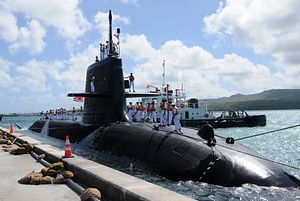The Japan Maritime Self-Defense Force (JMSDF) will dispatch a Soryu-class diesel-electric attack submarine to Sydney next month to participate in a joint naval exercise with the Royal Australian Navy and Royal Australian Air Force, ABC News reveals.
The 4,000-ton Soryu-class stealth submarine JS Hakuryu, outfitted with a new lithium-ion battery propulsion system, will be joined by two JMSDF destroyers and two helicopters during the training exercise aimed to “foster collaboration” and “improve tactical skills,” according to JMSDF officials. All in all, around 430 JMSDF personnel will participate in the drill.
Japan’s Mitsubishi Heavy Industries and Kawasaki Heavy Industries with its Soryu-class still appear to be the frontrunner in the competitive bidding process for a $50 billion ($38.8 billion) contract to build Australia’s new submarine fleet in partnership with Australian industry.
Malcolm Davis from the Australian Strategic Policy Institute told ABC News that this is a major development in the bid for Australia’s largest defense procurement program ever (the so-called SEA-1000 acquisition project)—a contract to build up to 12 new submarines for the Australian Royal Navy, replacing the six Collins-class submarines currently in service.
“By sending a Soryu-class submarine down to work with our Navy, they’re clearly very confident that the Soryu will impress and when you look at what they’re doing — they’re doing anti-submarine warfare exercises — they’re doing tactical maneuvering, communications, PHOTEX [photographic exercises] and so forth,” Davis noted. “Clearly the goal here is to demonstrate how effective the Soryu is in terms of tracking and evading being tracked by our ships,” he added.
However, as I pointed out previously, the submarine may not be the best option for Australia:
[O]n average Japanese subs are constructed to last for around 19 years, whereas the Australian governments expects at least a 30-year active service life span. The Japanese boats also have much less accommodation space than Collins-class submarines.
Additionally, the much talked about air-independent propulsion (AIP) system is actually Swedish technology. However, the Australian government has so far not shown any interest in AIP, preferring a lithium-ion battery option, which will be built into the next batch of Soryu-class subs. Nevertheless, advanced lithium-ion batteries are one of Japan’s top military secrets and it seems unlikely that Tokyo has agreed to share this sensitive technology with Canberra despite media reports.
The Japanese subs also allegedly have less range than the current Collins-class submarines in service. Furthermore, another concern is the integration of a U.S. combat system and weapons ( Mk 48 Mod 7 CBASS heavyweight torpedoes) into the Japanese hull.
In November 2014, Australia’s Senate Economics Legislation References Committee rejected the Soryu-class as a replacement option over some of the concerns outlined above. Japan is currently locked in a fierce competition with German defense contractor Thyssen Krupp Marine Systems (TKMS), offering a scaled-up version of its 2,000-ton diesel-electric Type 214 submarine (also equipped with lithium-ion battery technology), and French defense contractors DCNS, who is proposing a 4,000-ton version of the French Navy’s Barracuda-class nuclear powered attack submarine, dubbed the Shortfin Barracuda Block 1A.































